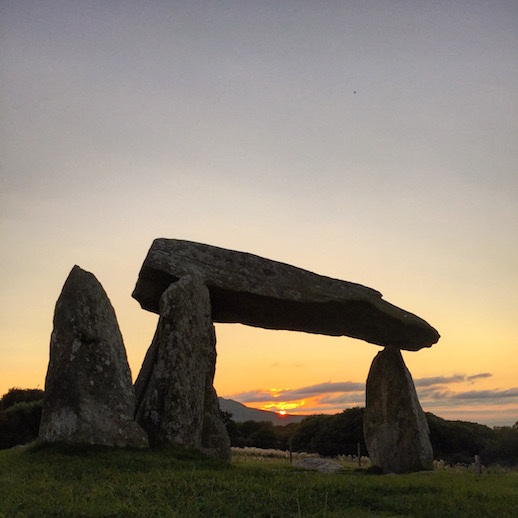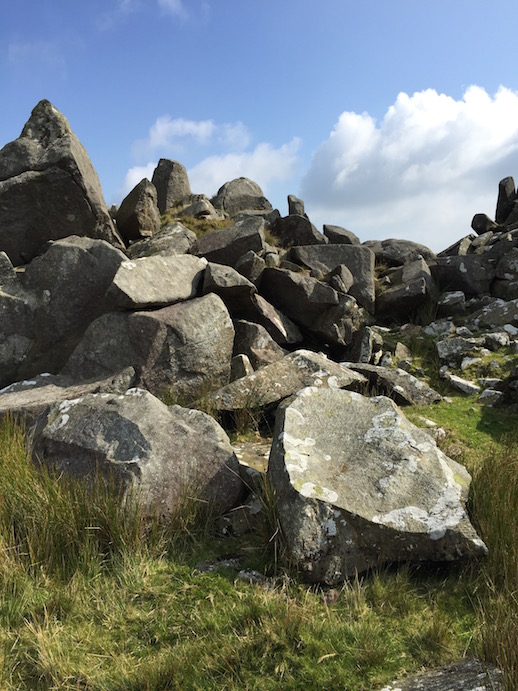 Words and pictures: Luke Turner
Words and pictures: Luke Turner
The broken saw tooth Carns of the Preseli mountains grate the glare-rimmed clouds of early autumn. On the slopes below red kites and buzzards make lingering turns over a tractor and ridges of newly cut hay, a rare lurid green against tired valley leaves. The fields stop suddenly, before heather (flowering purple in the sun, outdoing any garden petals wilting into September) blazes in a vivid rug woven with yellow sheep-cropped grass and grey rock.
At the nearby Pentre Ifan burial chamber the evening before, I yomped clumsily down a path and clattered through a wooden gate to try and catch the sunset, disturbing a solitary Japanese tourist snapping away at the 5000-year-old monument. He departed with a respectful bow towards the candle orange sky. I took a photograph of the sun through the gap between the two vertical slabs and the horizontal capstone (streamlined like a spaceship) across them on top, and immediately felt daft both for my insensitive instinct to capture everything and for mixing my megalithic aesthetics. This would of course have been built as the core of a burial mound, not a place of celestial worship. I say ‘of course’, but there’s a lot of faith involved with the practice of divining meaning from structures that predate history, and there’s now quite a schism as to whether or not the stones of Petre Ifan actually did once sit beneath a mound of earth.
Similarly, since the 1920s various archaeologists and geologists have claimed that some of the bluestones of Stonehenge come from Carn Menyn, on the Preseli ridge above the hay harvest. Others now say they were hewn out of Carn Goedog, a few hundred yards away. I tend to feel that it doesn’t matter, considering some poor buggers had to cart them the 160 miles to Wiltshire for reasons unknown and unexplained. Whatever they motivated them to such a task when just to walk up the hillside to Carn Menyn has me sweating through my Fred Perry is worth our respect.
I pick up a stone, and whack one of the large oblong rocks. A dull crack. My friend Mark Pilkington, who knows about these sorts of things, had told me that the rocks of the Carns about the village of Mynachlog-ddu would ring like bells if you hit them. Some scientists think that resonance, so familiar to us in the sonically bouncy modern concrete world, was such an alien sensation to ancient people that it was a sacred sound. Cave paintings, the earliest art, often occur deep under the surface at the underground chambers’ most resonant points. The resonance of the Welsh stones might have been the reason for them being ascribed mystical properties and sought after by the builders of Stonehenge, in the news this morning thanks to further new discoveries that make it seem unfinished, ever-evolving, a Neolithic Sagrada Familia. It must be the fate of religious structures of all eras to resemble fish tank ornaments.
I thump a diamond shape rock that would have made a fine addition to any stone circle. Sure enough, a metallic, melodic, percussive ring. A group of walkers look over strangely at my friend and as I as we clamber up and over the Carn, bashing away at rocks. Some ding, some don’t. Trying to use the Voice Memo app to capture the sound, I nearly crush my phone. Whack whack, clunk dong bing. It feels magic to me and I’ve got a pair of Sennheiser headphones in my bag, hours of music in my back pocket. No wonder the whoever-they-weres had been inspired to move these great chunks of mountain.
There’s a lot of faith in stone and stone seen in faith round these parts, from the ghost feet of prehistory to the hardily trudging souls of the 19th and early 20th centuries. Not far away is St David’s Cathedral, which was nearly destroyed in the Reformation and Civil War. The informative boards there display overly-dramatic Victorian prints of a building that’s splitting in half. It was ‘rescued’ by the architect George Gilbert Scott, and an organ echoes around the bare stone pillars of the nave that still sit slightly off the vertical. Down in Pembrokeshire’s steep sided valleys you come unstuck, as I did, trying to navigate by chapels, assuming that because you’ve stumbled across one near a village it must be the same establishment as you passed an hour or so before. I swear one small village had five. Built of dark stone next to graveyards stuffed with monuments at once dour and grand, non conformist asceticism stretching only unto death, they seem to be teetering on the brink. There’s little in the way of punning evangelical zeal on the signboards outside, though surprisingly few have been converted into holiday homes and they still exert a presence over the countryside.
In the towns, Carmarthen especially, shop windows are whitewashed or boarded up, leaving only the chain shops of modern Every Britain: Boots, Costa, Poundland, Cash Converters, Cancer Research. Always community-minded, Druids, monks and Methodists alike would find this state of things lacking. They might be happier at a village car boot sale I went to earlier that morning, antique copper brandy ladle £2, “bra’s” for sale £1.50, a castle ruin towering above an ice cream van. I overheard a few elder members of the community talking: “There are dark forces in this town you know. Witchcraft. People are putting garlic outside their houses”. Another replied: “ah well we do have a lot of students coming down this way. From Cardiff”. I have to double take just to be certain I’ve not accidentally dropped in on a script read-through by the local am-dram society.
The night lowers itself across the Preseli Mountains. In the distance on the summit of Foel Drygarn, the highest peak in the area, three rough stone burial cairns or remains of shelters (depending on the archeological sect you follow) catch a lingering touch of the sun. A concrete Ordnance Survey trig point sits up there, painted white by some wag, and in the fading light it glows like a ghost or an angel.
Luke Turner is co-founder and editor of online music and arts magazine The Quietus. He has also contributed to Q, The Guardian, NME, MOJO and the BBC and is currently researching a book on London’s Epping Forest

